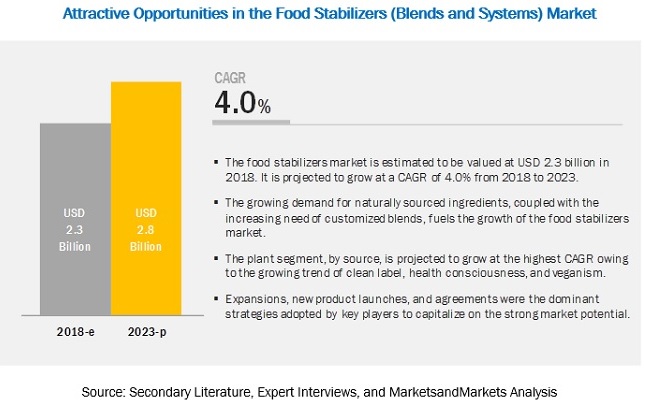
The food stabilizers (blends & systems) market was valued at USD 2.3 billion in 2018, and it is projected to grow to USD 2.8 billion by 2023, at a CAGR of 4.0%. The key players profiled have a strong presence in the global food stabilizers (blends & systems) market.
The food stabilizers (blends & systems) market is driven by factors such as versatility of food stabilizers in various food & beverage products and an increase in demand for customized products by food manufacturers and growth in concerns toward naturally sourced ingredients. According to the Food Marketing Institute 2015, US Grocery Shopper Trends Report, more than 25% of the consumers preferred natural food ingredients and more than 35% of consumers preferred no artificial ingredients in their food products. With the increasing popularity and consumption of convenience and ready-to-eat food products, the demand for customized food & beverage stabilizer blends and systems is projected to grow.
Food & beverage manufacturers gain economic benefits by using food stabilizer blends and systems, which led to increased demand. For instance, in dairy applications, carrageenan is broadly used stabilizer to provide thickness and richer mouthfeel in ice creams, cheese, and creamers as well as in beverages such as chocolate milk. In bakery applications, xanthan is widely used for water retention during baking. The multi-functionality of these stabilizers, coupled with the growing demand from the food & beverage industry, drives the market.
The Asia Pacific region is projected to be the fastest-growing market for food stabilizers (blends & systems) for the next five years. The abundant availability of raw materials such as seaweed and guar gum, along with the growing popularity of dairy products, beverages, and convenience food, is a growth driver in the Asia Pacific food stabilizers market. Developing economies such as China, India, and Japan are potential markets for the food stabilizers. The main driving force for the growing market is the scope and range of innovative system solutions and food processing technologies.
Request Sample Pages: https://www.marketsandmarkets.com/requestsampleNew.asp?id=41788893
This report includes a study of the development strategies adopted by leading companies and their product portfolios. It includes major players such as Cargill (US), DowDuPont (US), Tate & Lyle (UK), Kerry (Ireland), CP Kelco (US), Palsgaard (Denmark), Ashland (US), ADM (US), BASF (Germany), Ingredion (US), Hydrosol (Germany), and Nexira (France). These players are focusing on mergers, acquisitions, expansions, investments, joint ventures, partnerships, and new product developments to strengthen their customer base and market position in the food stabilizers market.
Plant-derived stabilizers dominated the food stabilizers (blends & systems) market in 2017. The food stabilizers market is projected to grow with the increase in demand for natural-based food additives at a global level. Plant-sourced stabilizers are usually obtained through plant cell walls, tree exudates, seeds, tubers, and roots. Plant-sourced food stabilizers include pectin, guar gum, locust bean gum, and gum arabic. Demand for plant-sourced food stabilizers is increasing due to the rising demand for natural food additives and increasing trend for vegan food products as well as the raw material prices are low as compared to the other sources.
Based on function, the food stabilizers (blends & systems) market has been segmented into texturizing, stabilizing, moisture retention, and others (egg replacement, mouthfeel, and synthesis control). The texturizing segment is projected to grow at the higher CAGR during the forecast period. Food stabilizers have been used for several years to provide the desired texture in various food products such as ice cream, yogurt, and baked products. The consumers prefer purchasing food products that are soft during consumption and have desirable texture and shape. All these factors have fueled the overall market growth of food stabilizers.